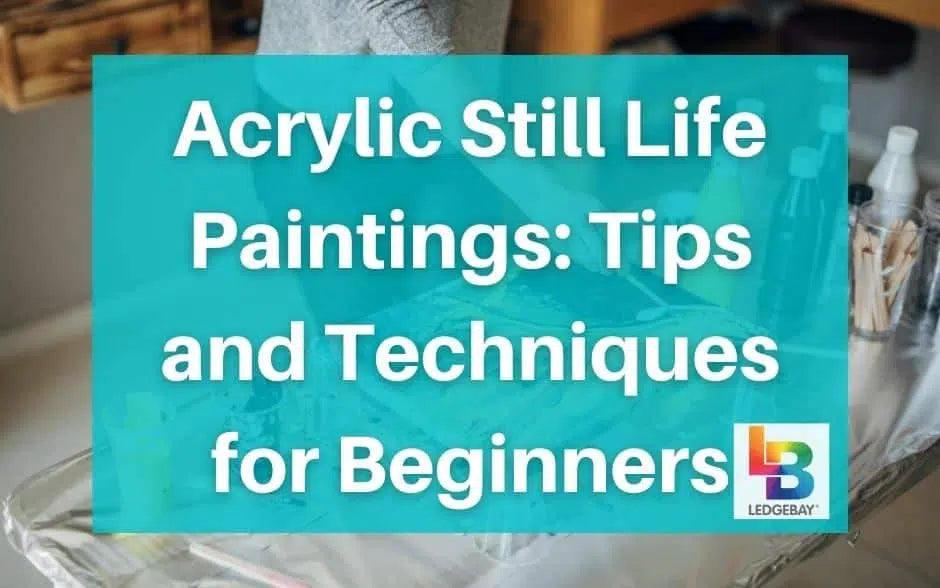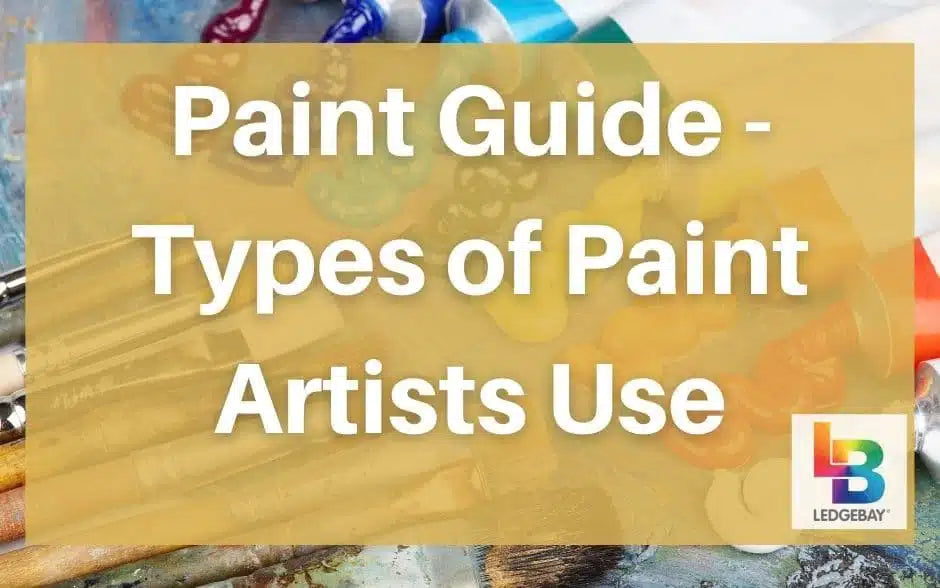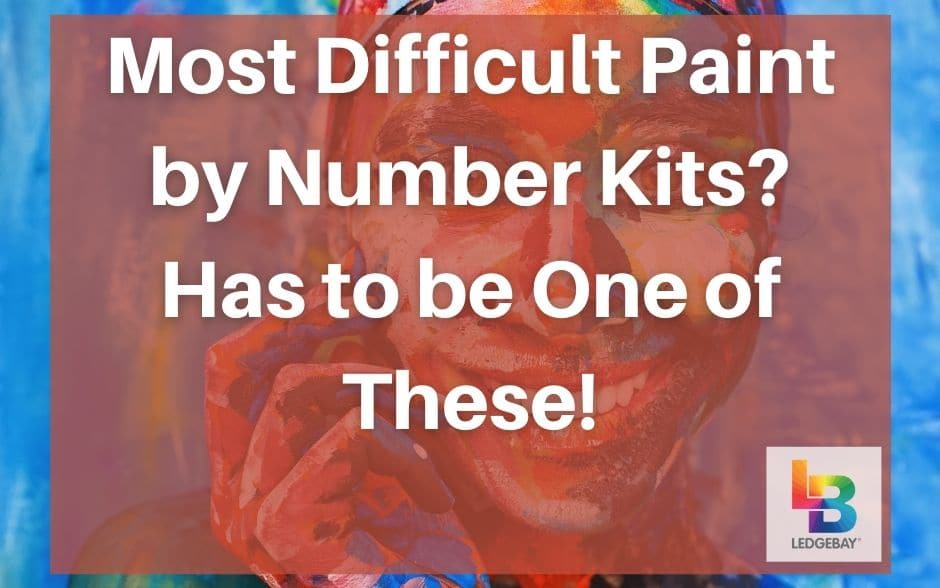If you're new to acrylic paintings , one subject you might want to try is acrylic still life paintings. This type of painting involves creating realistic images of objects in a static setting. As with any other form of art, there are techniques and tips you can learn to make the process easier and produce better results.
In this blog post, we'll discuss some basic tips for acrylic life painting, as well as some techniques that will help you create more realistic images.
What Is Acrylic Still Painting?
 Acrylic still painting involves the use of acrylic paint to create a painting of inanimate objects. This type of painting is often used to capture the beauty of everyday objects, such as flowers or fruits.
Acrylic still painting involves the use of acrylic paint to create a painting of inanimate objects. This type of painting is often used to capture the beauty of everyday objects, such as flowers or fruits.
Beginners might think that it is boring when compared to paintings of history, landscapes, or portraits that show emotion. But some of the best still life's have complex messages (stories) that are told through the objects shown and how they are arranged.
Can Be Both Realistic And Abstract
Acrylic paint is a fast-drying medium that can be painted directly to canvas or other surfaces. It is also extremely versatile, allowing artists to create a wide range of effects. As a result, it can be both realistic and abstract . Regardless of the style, these paintings are always vibrant and full of life.
[amazon box="B09NXPLSLL"]
Give The Picture A Symbolic Meaning
When you search for a still-life composition, keep in mind that the things you see may be symbols that give the picture a symbolic meaning. Like landscape painting, doesn't usually include people, it can still send a political, moral, or spiritual message just as well as the most complicated examples of history painting.
This went against the "official line" of academic art, which said that still-life art was the worst of the five types of art, after history, portraits, genre paintings , and landscapes.
4 Types Of Acrylic Still Painting
 Still life can be put into four main groups: pieces with flowers , pieces with breakfast or dinner, pieces with animals, and pieces with people. Many of these pieces were made just to show off the artist's technical skill and drawing ability.
Still life can be put into four main groups: pieces with flowers , pieces with breakfast or dinner, pieces with animals, and pieces with people. Many of these pieces were made just to show off the artist's technical skill and drawing ability.
It can also be painted to show a certain view of art (like Paul Cezanne's pre-Cubist still lifes) or to show how an artist feels (like Van Gogh's "yellow" sunflower studies).
But sometimes an artist wants to say something more complicated. So, the last group is called "Symbolic Still Life." This is a broader category that includes any kind of still life that has a clear symbolic story.
It is usually about religion or something close to religion. One type of painting called a "Vanitas" has this kind of symbolism
What Materials You Will Need?

Common Tools
- Brushes- A variety of brushes will be needed for it, including round, flat, and filbert brushes.
- Paints- A set of acrylic paints is a must-have for this type of painting. You'll need a variety of colors to create realistic images.
- Palette- A palette is used to mix paint colors. This can be a disposable limited palette or a more durable one that can be reused.
- Canvas- A canvas is the surface on which your artwork will be created. Canvases come in a variety of sizes, so choose one that is appropriate for the size of the painting you want to create.
- Reference Photograph- You will also need some reference photographs to work from. We recommend taking your own photos, as you'll have more control over the lighting and composition.
However, you can also use stock photos or images from magazines that are age appropriate, if relevant to your passion much better. Just be sure to choose high-quality images that are in focus and have good lighting.
[amazon box="B00PR1UWAU"]
The Color Palette For Paints
Use a mix of oil paints from Winsor & Newton. For the colored ground, use acrylic paint made for kids. You can also use a slow-drying paint with a slightly softer consistency just like the Golden Open Acrylics
Other Ground Colors You May Use Includes:
- Burnt sienna Acrylic
- Burnt Umber
- Acrylic Pale Umber (Winsor & Newton, Galeria)
- Alykd Titanium White (Winsor Newton)
- Acrylic Burnt Umber Alykd (Winsor & Newton)
- Blue Winsor Acrylic Paint (Winsor & Newton)
- Phthalo Blue – Green Shade Acrylic Paint
- Burnt Sienna (Winsor & Newton)
- Ultramarine blue Acrylic Paint
- Winsor & Newton Cadmium Yellow Medium Acrylic Paint
Paint Mediums
The most common medium for oil paintings is a mixture of two things:
- Refined linseed oil is made from the flax plant's seeds. It makes paints shiny and clear, and it dries very quickly, so it's great for underpainting and the first layers. Refined Linseed Oil is a popular oil that can be used for many things. It is pale to light yellow and dries in three to five days.
- Turpentine, also called Odorless Mineral Spirits (OMS), is the traditional thinner or solvent for drying oils like linseed oil.
It is used to "cut through" the oil in oil paints . Because of this, it smells strongly of solvents, so it is best to use it in a well-ventilated area.
Instead, we suggest using an Odorless Mineral Spirit (OMS) like Gamsol, which is a safer solvent that allows oil painters to use most traditional painting techniques without sacrificing the fumes.
Steps For Acrylic Painting

Start Bold And Find The Piece of prose
Professional artists begin acrylic painting with a bold color and a brush for painters like ultramarine blue and burnt sienna. This is the first layer of paint, or "underpainting."
It will give your paint a colorful base to work on later. Don't care about drips in your canvas, instead want lots of bright colors.
Use a "viewfinder," which is a piece of card with a hole cut out in the shape of the board. You can close one eye and search through the other to see how it is put together.
Find Shapes.
Search for shapes as you put the bright color on in the canvas. Not only the shapes of the objects themselves, but also the shapes of the spaces between them.
Plan the composition of your acrylic painting with just a few simple marks. Keep everything very open and working all over the board.
Cover Up And Keep It Vague
According to a professional artist almost all of the white on the board is now gone, and the colors are bright. As darker colors are added, the objects become easier to see.
Slowly make way across the whole panel, try not to focus on the details and just on the big shapes. The flowers are made up of simple color blocks.
Next use thick layers of paint and draw into it with the end of an old brush. Do this while it's still wet. This makes a surface with different textures when you add some rough details to the coffee pot. This is still just the base coat, and we can't wait to see how the beautiful colors and textures come together.
Add More Color And A Little More Greenery
Use a big brush to add more color to the tabletop and between the flowers. In my setup, the cloth on the table is white, but at the moment it is green and blue in the painting. We'll add the white later. Scratch into the flowers with the end of an old brush.
I'm almost done with the underpainting at this point. We will give the coffee pot and fruit a little more shape and add some more leaves. Keeping the painting loose and sketchy.
The surface must have a lot of different colors and textures, and the main parts of the composition are there. You will need a cup of tea before you use your palette knife.
Use A Palette Knife
Using a palette knife to spread the paint. Use soft green for the background drape, with some of the orange showing through. Now, the fabric is white. The texture of the underpainting is picked up by the thick paint on the palette knife. You don't use much of it, so some of the bright colors show through.
[amazon box="1440308586"]
Add A Little Detail
With the knife, you can keep working without getting stuck on too many small details. As you paint around the objects, keep on looking for the negative shapes. Also, the green on the table helps the coffee pot and cups stand out. We will give the things a little detail, but we will keep it simple.
Don't Mess It Up And Know When To Give Up
The bright and light flowers stand out against the dark vase. Use the palette knife to paint the flowers , making sure to keep it clean. Paint quickly and directly, so the colors stay bright and the marks are clean. Describe how the petals look by looking at the shape of the knife.
It's not always clear when a painting is done. Think about what you wanted to accomplish. You should not aim for detail or accuracy. Instead, show a mood with expressive marks, bright colors, and different textures. There comes a point when working on a painting any longer would kill its energy and make the colors look dull.
Important Tips For Painting Still Life Scene

Do Preliminary Sketch Of The Subject.
It is often seen as complex and challenging works of art. However, with a little planning and preparation, they can be relatively easy to create. One of the most important steps in creating it is to do a preliminary sketch of your subject.
This will help you to determine the composition of the painting and to choose the colors that you will use. It is also a good opportunity to experiment with different brushstrokes and techniques. By taking the time to sketch out your painting beforehand, you can avoid making costly mistakes later on.
Select And Check The Colors
This is a tricky step because choosing colors that are close to what our eyes see can make a big difference in how well my painting turns out. When you work digitally, you can easily change the colors.
However, you couldn't do that when you worked with traditional methods. Sketch lights and shadows with a big hard-edged brush, noting that when the light is cold, the shadows have warm tones.
Check The Details Of Your Add On Subjects
 If you add details on your art journey such as cloth and fabric, make sure that you check the subject's details. First, use a smaller, soft-edged brush to outline the shape of the cloth. Make the shadows darker where the fabric meets.
If you add details on your art journey such as cloth and fabric, make sure that you check the subject's details. First, use a smaller, soft-edged brush to outline the shape of the cloth. Make the shadows darker where the fabric meets.
Before you move on to the glass objects, paint the reflected light on the fabric folds by taking the color from the well-lit parts of the wine glass (which is a bright and saturated red in this case) and the water jug with the Eyedropper tool.
Check The Lights And Reflection
if you are going to paint the glass and jug on a new layer and use the Eraser tool to make them look like they are made of clear glass. Glass is not only clear, but it also reflects light.
So add another layer and paint the drapery's reflections on the wine glass. Use a soft-tipped brush to keep from cooking them too much.
Lastly, add details to the objects and paint the blue lines on the cloth
Choose The Medium That Suits You
 When it comes to acrylic still painting , the type of medium you choose can have a big impact on the finished product. For example, if you're looking to create an acrylic still painting with a lot of detail, then using a thinner paint brush will be better suited for your needs than a thicker one.
When it comes to acrylic still painting , the type of medium you choose can have a big impact on the finished product. For example, if you're looking to create an acrylic still painting with a lot of detail, then using a thinner paint brush will be better suited for your needs than a thicker one.
On the other hand, if you want to add more texture to it then using a thicker paint brush will help you achieve that goal. In general, it's important to experiment with different types of mediums until you find the right fit for your acrylic still painting style.
And don't be afraid to ask for tips from experienced acrylic still painters - they can be a great resource when it comes to finding the perfect medium for your needs.
Pick The Subject You Are Interested To
There are a few acrylic still painting tips that you should tell your students. First and foremost, when doing your art journey it is important to pick a subject you're interested in. Most of the time, your passion and interest in the subject will show in the finished work.
For instance, if you really like roses, put some in your still life. Or maybe you like the shape of certain fruits and want to include them in your piece.
After all, you'll be spending a lot of time looking at it! If you're not interested in your subject, it will be very difficult to stay motivated throughout the painting process.
Put Together Your Scene With Care

Most people look from left to right when they look at the acrylic painting. This is what it means to say that a painting "reads." This natural progression can be changed by how you place your elements.
So keep in mind that when you're putting together your still life art piece. After you've decided what to put in your acrylic painting, you'll have to set it up.
There's a lot to remember, but here are the most important things:
a) Don't put things in a line or at the same distance from each other (this will make your painting repetitive)
b) Put some things close to the viewer and some things far away to give the picture depth.
c) Don't make your setup too busy.
d) Remember that a good still painting makes things that seem to be opposites work together ( big and small, sharp and soft, smooth and rough)
e) Don't put the main part of the picture on the left side of the canvas (this can affect how your painting is read)
Set Up A Proper Light Source
 It is a beautiful way to show off your favorite objects in your home. But in order to create a masterpiece, it's important to set up your light source correctly.
It is a beautiful way to show off your favorite objects in your home. But in order to create a masterpiece, it's important to set up your light source correctly.
Natural light is the best light for acrylic painting, but you'll need to set up your light source so that it's not too harsh or too weak. You'll also want to make sure that the light is shining on your subject from the front, so that you don't get any shadows in your canvas.
Take A Picture Of Your Set-up
Taking a picture of the set-up can be helpful in more than one way. It lets you look at the composition and make changes before you start with your canvas.
It also lets you take a picture of the set up in case you need to move it. The camera also shows light and shadow in a simplified way, which is helpful when you start making your still life.
Be Knowledgeable With Color Theory
 Color is one of the most important elements of any painting , and acrylic still paintings are no exception. A knowledge of color theory can help you to make a harmonious and visually pleasing art piece.
Color is one of the most important elements of any painting , and acrylic still paintings are no exception. A knowledge of color theory can help you to make a harmonious and visually pleasing art piece.
It can also be helpful in choosing the right colors for your subject matter. For instance, if your art piece is a bouquet of flowers, you will want to use colors that complement each other and show a sign of balance.
With a little knowledge of color theory, you can turn your acrylic still painting into a work of art that is sure to impress.
Make The Background Dark.
Since we're talking about background tones, we thought we'd give you one more tip. Keeping the background dark and simple will give your still life depth and help the colors and shapes stand out.
Add Depth To Your Still Life.
The great thing about this painting process is that you can turn an ordinary object into a work of art. It doesn't have to be the typical fruit scenes. You can use flowers, books, your favorite food (donuts count), or anything else you have around the house.
Use Both Smooth And Rough Edges.
How you paint the edges of your objects in your canvas can make a big difference in how they look and how 3D they look. Work on building up the shape of your objects instead of just drawing a line and filling it in with color.
This will help enhance the quality of your still life painting and make a 3D look. Use clean, sharp edges on flat things like paper or leaves, and round, soft edges on things like fruit.
Can YouTube Video Teach Me How To Paint?
 You might like free online painting tutorials, which can help you learn both basic and advanced painting techniques from the comfort of your own home. There are several videos online that teach the steps in acrylic painting.
You might like free online painting tutorials, which can help you learn both basic and advanced painting techniques from the comfort of your own home. There are several videos online that teach the steps in acrylic painting.
You may want to search for it on YouTube and check the quality of those services. Whether you want to learn how to paint with acrylics, oils, or watercolors, there are plenty of great channels on YouTube to help you get started.
You can download those videos you watch. Deliver and measure your progress repeatedly until you become familiar with the steps and techniques. There are also websites that offer free courses about acrylic painting on canvas , including details about managing your acrylic art activity.
How Can You Promote Your Art Acrylic Video Tutorials Online?
 There are many ways to promote your acrylic painting video tutorials online. You can create a website or continue to the YouTube homepage and tailored your blog or videos according to the content you're currently viewing and sharing.
There are many ways to promote your acrylic painting video tutorials online. You can create a website or continue to the YouTube homepage and tailored your blog or videos according to the content you're currently viewing and sharing.
Make personalized content and ads. Measure audience engagement and site statistics to understand how to develop and improve new painting tutorials for your viewers. To measure the effectiveness of ads, understand how viewers’ interest are influenced by things like quality, clarity and relevance of your content.
Depending on your settings, use cookies and data to customized YouTube homepage. Track outages and protect your homepage and tailored ads from spam fraud and abuse.
You can also promote your videos through other social media platforms like Facebook, Twitter, and Instagram. By promoting your videos online, you can reach a wider audience and help more people learn how to paint with acrylics.
Thanks for reading! We hope these tips were helpful in getting you started with still life art pieces. If you have any questions or comments, please feel free to leave them below. Happy painting!











